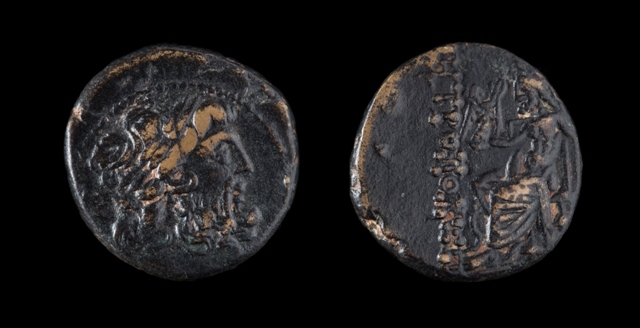Antioch-on-the-Orontes, Bronze Coin
Dublin Core
Title
Antioch-on-the-Orontes, Bronze Coin
Subject
Antioch-on-the-Orontes (autonomous city in Roman Syria), AE 19, 64-49 BCE.
OBVERSE: In dotted circle, Laureate head of bearded Zeus, in profile facing right. Inset in a circle of dots.
REVERSE: Enthroned Zeus Nikephoros, i.e., Zeus holding a winged Nike in his right hand, in his left a sceptre. Off-centered so that the right inscription (ANTIOXEWN THS) is missing; inscription left: (M)HTROPOL(EWS) (= Antiocheon tes metropoleos, "of the metropolis of the Antiocheans"). In left field next to leg: cornucopiae. Pompeian Era date in exergue off the flan.
OBVERSE: In dotted circle, Laureate head of bearded Zeus, in profile facing right. Inset in a circle of dots.
REVERSE: Enthroned Zeus Nikephoros, i.e., Zeus holding a winged Nike in his right hand, in his left a sceptre. Off-centered so that the right inscription (ANTIOXEWN THS) is missing; inscription left: (M)HTROPOL(EWS) (= Antiocheon tes metropoleos, "of the metropolis of the Antiocheans"). In left field next to leg: cornucopiae. Pompeian Era date in exergue off the flan.
Description
Antiochia-on-the-river-Orantes was fouded by Seleucus I Nicator in honor of his father Antiochus. The western Seleucid Empire used this city as its capital and its mint became one of the most important in the empire. Antioch was a very large city for the ancient world, at its peak reaching 500,000, making it the third largest city in the Roman Empire.
When Pompey reorganized the Roman province of Syria in 64 BCE, Antioch became a free city because it had rebelled against the last Seleucid king, Antiochus XIII, and thus continued to mint its own coins.
Zeus appears on both sides of the coin, a reference to the Seleucid history of the city, which often featured Zeus on its coinage and erected statues in his name. According to legend, the city was founded at the exact spot where an eagle, a symbol of the god, dropped a piece of sacrificial meat.
When Pompey reorganized the Roman province of Syria in 64 BCE, Antioch became a free city because it had rebelled against the last Seleucid king, Antiochus XIII, and thus continued to mint its own coins.
Zeus appears on both sides of the coin, a reference to the Seleucid history of the city, which often featured Zeus on its coinage and erected statues in his name. According to legend, the city was founded at the exact spot where an eagle, a symbol of the god, dropped a piece of sacrificial meat.
Source
Gift of James and Aneta McIntyre, Hallie Ford Museum of Art, Salem, OR. 2006.010.029
Date
ca. 129-125 BCE
Rights
Hallie Ford Museum of Art
Format
1.940 cm
8.300 gr
8.300 gr
Type
Coin
Coverage
This item can be viewed on Hallie Ford Museum of Art's website.
Citation
“Antioch-on-the-Orontes, Bronze Coin,” Hallie Ford Museum of Art Exhibits, accessed January 7, 2026, https://library.willamette.edu/hfma/omeka/items/show/81.
